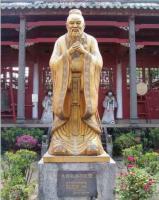Qufu and Mount Tai Introduction
 Qufu
QufuAbout 160 km south of Jinnan, the capital of Shandong Province, Qufu is a small city with an urban population of about 63,000 (2004). It is the birthplace of Confucius - the greatest Chinese philosopher 2500 years ago. Confucian ethnics were adopted by the subsequent feudal rulers to keep the populace in line, and Confucian temples were set up in numerous towns run by officials. Qufu acquired the status of a holy place, with the direct descendants of Confucius as its guardian angels.
The town of Qufu has three basic attractions: the Temple (built around the house that grew up in), the "Forest" (the Kong family cemetery where over 100,000 of Confucius' descendants have been buried in the last 2500 years), and the Ming-era mansion compound where the descendants of Confucius lived a nobility.
Every year from September 26 - October 10 "Qufu International Confucius Culture Festival" is sponsored here. During the period, tourists can see and take part in many celebration activities. The Temple of Confucius, Cemetery of Confucius, and the Kong Family Mansion in Qufu, have been listed as UNESCO World Heritage Sites since 1994. They are the major cultural attractions of Qufu.
The temple, cemetery and family mansion of Confucius, the great philosopher, politician and educator of the 6th-5th centuries B.C., are located at Qufu, in Shandong Province. Built to commemorate him in 478 B.C., the temple has been destroyed and reconstructed over the centuries; today it comprises more than 100 buildings. The cemetery contains Confucius' tomb and the remains of more than 100,000 of his descendants. The small house of the Kong family developed into a gigantic aristocratic residence, of which 152 buildings remain. The Qufu complex of monuments has retained its outstanding artistic and historic character due to the devotion of successive Chinese emperors over more than 2,000 years.
-- http://whc.unesco.org
Mount Tai
The sacred Mount Tai ('shan' means 'mountain') was the object of an imperial cult for nearly 2,000 years, and the artistic masterpieces found there are in perfect harmony with the natural landscape. It has always been a source of inspiration for Chinese artists and scholars and symbolizes ancient Chinese civilizations and beliefs.
-- http://whc.unesco.org
Chinese southerners always like to say they have "thousands of mountains, rivers and genius". But those from Shandong talked back with "one mountain, one river and one saint": Mount Tai (Taishan), Yellow River and Confucius, implying that the three means a lot more than those in numbers.
Located 70 km north of Qufu, Mount Tai is most reversed of the five sacred Taoist mountains of China. The word "Tai" in Chinese means stability and peace. Powerful emperors in history like Qinshihuang of Qin Dynasty, Wudi (140-87 BC) of Han Dynasty, Taizong (626-649) of Tang Dynasty, and Taizu (960 - 976) of Song Dynasty, during their reign, China became united and strong, had all come and held grand ceremonies to pay respect to Mount Tai.
Therefore, Mount Tai has always been important to the Chinese people. Ancient rulers and common people usually paid homage to the mountain, in the hope of bringing blessing and good luck.